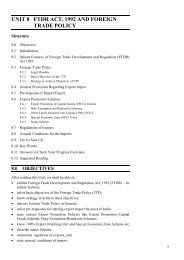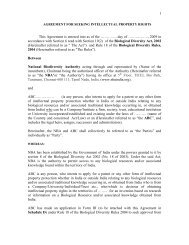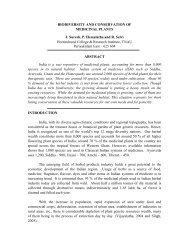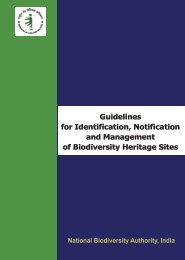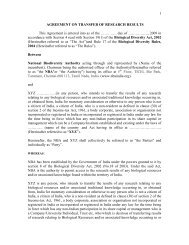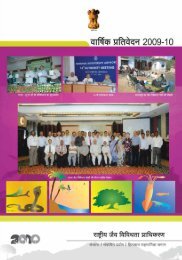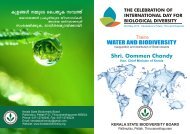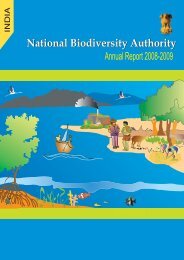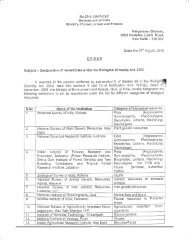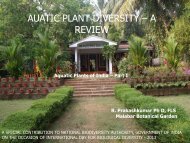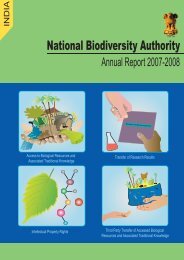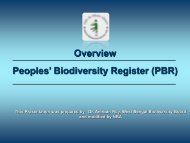Report - National Biodiversity Authority
Report - National Biodiversity Authority
Report - National Biodiversity Authority
Create successful ePaper yourself
Turn your PDF publications into a flip-book with our unique Google optimized e-Paper software.
Afghanistan Bangladesh Bhutan India Maldives Nepal Pakistan SriLankaA <strong>Report</strong> on the Training on<strong>National</strong> Legislation on<strong>Biodiversity</strong> forGovernment officials ofSAARC Member StatesThree day training on “<strong>National</strong> Legislation on <strong>Biodiversity</strong> for Government officials of SouthAsian Association for Regional Cooperation (SAARC) Member States” was held from 29th to31st August, 2012, at Hotel Radisson Blu, Mamallapuram. 32 delegates including 11 fromdifferent State <strong>Biodiversity</strong> Boards (SBBs) and one representative from Bangladesh took part inthe training which was organized by the Ministry of Environment and Forests, Govt., of India incollaboration with <strong>National</strong> <strong>Biodiversity</strong> <strong>Authority</strong> (NBA), Chennai.
ObjectiveThe objective of this training was to strengthen the collaboration between India and the otherSAARC Member States, on issues relating to environment, biodiversity, effectiveimplementation of the provisions of Convention on Biological Diversity (CBD) and on preparingfor the Conference of the Parties (COP) 11 to CBD. Further it aimed to provide an opportunityfor CBD focal points and legal experts within the SAARC region to interact and exchangeexperiences and identify suitable sub-regional programmes.Ten workshop sessions based mainly on experiences from experts in the field of environmentand biodiversity related policy and legal issues: Intellectual Property Rights (IPRs), TraditionalKnowledge (TK) and Access and Benefit Sharing (ABS) were conducted.
PRESENTATION ON INDIA’S BIOLOGICAL DIVERSITY ACT, 2002 AND BIOLOGICAL DIVERSITY RULES,2004:Shri.C.Achalender Reddy, Secretary, <strong>National</strong> <strong>Biodiversity</strong> <strong>Authority</strong> (NBA), Chennai, spokeabout India’s biodiversity, institutions and laws and the close link between biodiversity andlivelihood. He discussed how India had become a State party to the CBD and the subsequentenactment of the Biological Diversity Act, 2002. He elaborated on the birth of <strong>National</strong><strong>Biodiversity</strong> <strong>Authority</strong> (NBA) and the development of new concepts such as People’s<strong>Biodiversity</strong> Registers (PBRs), ABS (PIC, MAT, MTA) etc. He emphasized the importance ofPIC in recognising the rights of the local people and the conservation of traditional knowledge.He discussed the implementation of the Act - through a three tiered institutional structure withNBA at the national level, SBBs at the state level and <strong>Biodiversity</strong> Management Committees(BMCs) at local level, describing in detail the mandates of NBA and about the penalties andoffences under the Act in comparison with the forest and wild life protection legislations.He elaborated on the composition,functions and operational mechanisms ofNBA, especially its operation with theassistance of expert committees on ABS,Agro biodiversity, Normally TradedCommodities (NTC), Medicinal Plantsand others. Other initiatives andprograms of NBA were discussed viz.,NIUCBD, Taxonomy Expert Database,FRLHT, UNDP, WII, which it undertakes with other organisations.The role of central government in establishing NBA, developing strategies, plans, programmesetc., for biodiversity, issuing directives to the state governments for conservation of threatenedhabitats, were also dealt with in his address.Status of progress for the period upto July 2012 was presented and he discussed about the roleof state governments in establishing SBBs and constituting BMC’s. The new concept ofconservation called <strong>Biodiversity</strong> Heritage Sites (BHS) was appraised and he stated that sacred
groves can be identified in the state by SBBs and with BMC’s involvement, declare it as a BHS.As of date 4 BHS have been notified he stated.He also discussed the progress made in clarifying the interpretation of guidelines oninternational collaborative research projects, online expert database, ABS mechanism: itsprocess and progress.Before enactment of the Act – Kani story –TBGRI model had served as good ABS model, heemphasized.He also discussed the key challenges faced to strengthen the mandates of NBA, includingframing of guidelines for BMCs through a committee constituted for the same.The importance of conservation activities in the high sensitive biodiversity area of Andaman andNicobar Islands was stressed.
PRESENTATION ON ISSUES, CONCERNS AND CHALLENGES FROM A LEGAL PERSPECTIVE ON THELEGISLATIVE FRAMEWORK ON BIODIVERSITY:Dr.M.K.Ramesh, Professor at the <strong>National</strong> Law School of India University, Bangalore, said thatCoP 11 was a lifetime opportunity for those who were engaged in negotiation deliberations andthat it was an opportunity to make policies at the global level.He further added that the Parties to CBD make an attempt tomainstream the legal policies at the higher level, flag the issuesand take tentative steps to ensure a particular level ofcompliance and set the agenda for future, which will limit thefocus of attention.1 Prof: Dr.M.K. RameshHe spoke on issues on sustainable resources, primarilyconcerned about conservation of resources, conservation ofvalues and knowledge system, issues of bio-safety from alieninvasive species and from LMOs and GMOs, bio-piracy, dealingeffectively with injustice and equal trade.He discussed international and national legal responses and strategies including principle ofprecaution, co-operation, public trust doctrine and equity; conservation strategies including insitu & ex situ, heritage site tag, forest and wild life conservation areas/protection of endangeredspecies, critical wildlife habitats, bio-safety and protocol concerning LMO’s and GMO’s withregard to Invasive alien species.CoP 9 decisions on global strategy for plant conservation, regional rearrangements,international co-operation, GEF & World Bank’s financial and technical assistance werediscussed.Regional strategies for CoP 11 to showcase achievements such as HST for Western Ghats,involvement of Forest Rights Act in protecting community rights and wild life habitats, approvalof an expert for BT Brinjal by the Supreme Court, prevention of encroachment of conservationareas, need for harmony to be maintained and documentation of the XII Plan, were discussed.
He opined that NBA cannot work in isolation and that it needs support and co-operation fromother agencies. He proposed measures to strengthen CBD regime.He put forth the target subscriptions of state agreement with respect to legal framework andsuggested that law should be prescriptive and cognitive. He also stated that a beginning can bemade with CoP 11 as efforts should start there to bring into force primary principles of law.He stated that by bringing concerns complementary to each other a legal action plan could beevolved just like in the case of Forest Rights Act. He further added that formulatory laws areexisting; however have to be worked out in detail, even though they cannot be precise. Atleastan attempt has to be made, he said. He opined that the definition of PIC should includeelements of “free consent” and should not merely refer to equality between parties, rather to doequity to people.While detailing on Bio-Safety Protocol, he stressed on introduction of safeguards while thecommerce is also done at the same time. He suggested in evolving better internal legalmechanisms to ensure compliance. He concluded by stressing on the need for co-ordinationand harmony amongst various legislations on environment, biodiversity, industrialization etc.,and to bring about reforms in laws that work in conflict with or overlap and override biodiversity.
PRESENTATION ON ISSUES ON NAGOYA PROTOCOL:Prof.L.Pushpa Kumar from Delhi University delivered a presentation on issues relating toNagoya Protocol. He said that Nagoya Protocol ought to be healthy for certain countries as itensures equity for the people who preserve traditional knowledge. Implementing challenges withspecial reference to developed countries are given more importance and the objective of theProtocol covers a wide range of issues, he said.2 Dr. L. PushpakumarHe highlighted, Article 5 and 6 that deal with fair andequitable benefit sharing and related issues and access togenetic resources respectively. Further, He explainedArticle 7 which provides access to Traditional Knowledgeassociated with Prior Informed Consent (PIC) and MAT(Mutually Agreed Terms) and also disclosed the necessityto ensure that local communities are benefited through ABSagreements and the need of capacity building training onsuch issues. He spoke on Article 8 that highlights thespecial considerations to promote biological resources andalso emphasized that the genetic resources related to foodand agriculture should be given equal importance. Heelaborated Article 9 that deals with Conservation initiativesand Article 11 which explains about the trans-boundarycooperation.He also emphasized the specific check points that had to be recognized to monitor the flow ofgenetic resources and traditional knowledge, like some of the major check points identified thatmay include NBA, NBPGR. He said “they should be oriented with values of importance, creatinglinkages with other agencies. User country obligations are essential to access and utilizegenetic resources. India serves best example for user as well as provider country. If training oncapacity building and issues on implementing the law is effectively done then the country’sdevelopment would gradually increase. Civil society groups should also be involved to educatepeople. In addition, legal practitioners, patent agents, private institutes should also be activelyinvolved.”
PRESENTATION ON BANGLADESH BIODIVERSITY POLICES AND LAWS:Mr. Md. Majibur Rahman, SeniorAssistant Secretary, Law and JusticeDivision, Ministry of Law, Justice andParliamentary Affairs, Bangladeshinitiated the session stating thatbiodiversity has become a globalconcern and that it is essential toconserve the threatened biodiversityadopting various programmes andstrategies both at national and regionallevels. He said “Governmentsthroughout the world have beenstrengthening their conservationcapacity by developing and adopting various policies, legislations and innovative approaches.”He extended his statement saying that Bangladesh is the world’s largest deltaic regionencompassing about 5,700 species of angiosperms that include 68 woody legume species, 130fiber yielding species, 500 medicinal species, 29 orchid species and 3 species of gymnosperms.Apart,from the above, he added that 1,700 pteridophyte species have also been recorded fromthe country.He stated that the country also possesses a rich faunal diversity and has approximately 113species of mammals, more than 628 species of birds (both passerine and non-passerine), 126species of reptiles, 22 species of amphibians, 708 species of marine and freshwater fish, 2,493species of insects, 19 species of mites, 164 species of algae (or seaweed) and 4 species ofechinoderms.He pointed out that like in other regions around the globe, the biodiversity of Bangladesh is alsoentering through a critical period. Already, 12 wildlife species have become extinct from thecountry. In addition, IUCN (2000) has listed a total of 40 inland mammal species, 41 birdspecies, 58 reptiles and 8 amphibians under various degrees of risk in the country, and the
Bangladesh <strong>National</strong> Herbarium reported 106 vascular plant species under risk of variousdegrees of extinction in the country.He further stated that Bangladesh has no specific laws on biodiversity but has adopted variouslegislative policies and inventions to conserve its remaining biodiversity. The country has ratifiedmost of the international treaties and conventions related to conservation of biodiversity.Some of the major legislative policies and approaches taken by the government which provideprovisions for biodiversity conservation in the country are• <strong>National</strong> <strong>Biodiversity</strong> Strategy and Action Plan (NBSAP);• <strong>National</strong> Conservation Strategy (NCS);• Bangladesh Wildlife (Preservation) Order, 1973;• Bangladesh Forest Act, 1927 and subsequent amendments;• <strong>National</strong> Environment Management Action Plan (NEMAP);• The Bangladesh Environment Conservation Act, 1995 and Environment ConservationRules 1997;• The Pesticides Ordinance, 1971;• The Environment Courts Act-2000;• Sustainable Environment Management Programme (SEMP); and the• Nishorgo Support Project (NSP) for the co management of protected areas.The declaration of PAs for biodiversity conservation is rather a new concept in Bangladesh, hesaid. In 1974, the Bangladesh Wildlife Preservation Act defined three types of PA underdifferent IUCN protected area management categories in the country, viz., wild life sanctuary,and national park and game reserve.Though various threats have been posed on PAs of Bangladesh, government has takeneffective measures to face the challenges, he concluded.
PRESENTATION ON NATIONAL BIODIVERSITY ACTION PLAN:In his presentation Dr. Daniels said that every country has its own mandates in implementingthe action plan. In fact, India delayed in implementing andfinally developed its first action plan in 2008. The action planhas to be revised and updated every five years and it iscrucial to give a comprehensive background, he said. The first<strong>National</strong> Action Plan for the country was prepared in 2008and formally adopted in 2009.He emphasised the achievements made by India for the pastfew years and also suggested that these achievements canbe showcased during the CoP-11. Though certain deficitexists, major gaps can be identified and workable targets canbe set, he said.targets which can be presented in CoP-11,using them as instruments for effectiveintegration, monitor and review theimplementation, synergies among thebiodiversity related conventions, promoting thegeneration by using scientific information.” Hefurther stressed on employing regionalcooperation. India is in the process of preparingthe 12 fifth year plan.He stated “in the global context, strategic planhas to be set for achieving Aichi <strong>Biodiversity</strong>targets. 2011 – 2020 has been declared as thedecade of biodiversity with the theme “Living inHarmony with Nature”. The main purpose ofthis strategic plan is effective implementationand shared vision & mission. It urges parties toenable participation, develop national andregional targets, reviewing and updating the
He emphasized the efforts of initiating action to address the underlying causes of biodiversityloss by mainstreaming the biodiversity concerns and taking actions to decrease the directpressures on biodiversity. The Strategic Plan includes 20 headline targets for 2015 or 2020 (the"Aichi <strong>Biodiversity</strong> Targets"), organized under five strategic goals that is operated both at globaland national level. This can be better explained as aspirations for achievement at global leveland a flexible framework at the national or regional level, he added.He said “in terms of national context, intergovernmental co-operation and achievable targetsthat provide opportunities for cross-sectoral integration are focused. Nearly 10 major threatsare identified.” He finally concluded by saying that Aichi Target 1 is the most relevant in makingpeople aware of biodiversity values and conservation and Target 4 that states, “stakeholders atall levels have taken steps to achieve or have implemented the plans”.PRESENTATION GUIDELINES FOR BIODIVERSITY MANAGEMENT COMMITTEES (BMCS):Dr. V. Arivudai Nambi from MSSRF made adetailed presentation on the Guidelines for<strong>Biodiversity</strong> Management Committees beingfinalized by the committee constituted for thesame and highlighted the methods and processinvolved in initiating BMCs in Tamil Nadu. Healso discussed about the the ground realities ofvillages in biodiversity conservation. Nallur wasdesignated as the India’s first Local HeritageSite.He also projected the BMC formation method with indication of risks involved in BMC formation.He listed out the total BMCs, PBRs, BHS in India. Technical Support Groups (TSG) organizedby SBBs for strengthening BMCs at Village, Block and District level and Financial Resources forBMCs were the key notes focused.He also suggested the draft guidelines for BMCs and to implement Biological Diversity Act andRules to the local knowledgeable persons. Invitees from departments of Forest, Agriculture,
Livestock, Health, Fisheries, and Education were also given special attention. He insisted thatBMCs should develop linkages with other committees like Joint Forest Management(JFM),Forest Conservation Committees (FCCs) and Eco Development Committees (EDC) formatters related to wild biological diversity and or biological diversity found in forest lands. Themanagement committees can be actively involved in the preparation of <strong>Biodiversity</strong>Management Plan using the outputs of PBRs, he said. The State <strong>Biodiversity</strong> Boards, he added,can facilitate the establishment of <strong>Biodiversity</strong> Heritage Sites in consultation with local bodiesand key stakeholders.A field trip to felicitate the delegates was organized by <strong>National</strong> <strong>Biodiversity</strong> <strong>Authority</strong> tohistorical sites including UNESCO heritage sites in Mamallapuram. All the delegates visitedMuthukadu and had a nice boating. Then they visited Crocodile bank and saw how Irulas wereextracting the snake venom from different venomous snakes. Later they visited the farm wheredifferent species of crocodile are maintained under captive breeding. After that the team visitedMamallapuram temple that was built 1400 years ago by Pallava’s.
PRESENTATION ON ACCESS AND BENEFIT SHARING MECHANISM:Ms.Suneetha M.Subramanian, discussed on the combination of monetary and non-monetaryincentives that would be optimal and the kind ofknowledge systems and innovations andinstitutional arrangements with regard to theABS mechanism in India. She spoke ofalternate models of benefit sharing that will beappealing and practical to communities andbusinesses.Her presentation detailed on communicationtools required to raise awareness on good practices among different stakeholders, constitutionalguarantees given to different stakeholders - especially ILCs and implementation effectiveness ofdomestic legal provisions.She expressed concern over the perception of local communities and innovators themselves onthe issues of benefit-sharing, the role of NGOs and civil society and influence of internationallaw.She discussed issues on TK ownership and the simultaneous occurrence of TK and biologicalresources, use of biological resources and TK in modified and unmodified form. She said,depending on user group, benefit sharing mechanisms should vary from being commercial andnon-commercial.She stressed on the importance of identification of check points to enable monitoring such asPIC, certificates of origin during filing of patents or registration of a product, etc.Broad guidelines anticipating different scenarios will be useful with respect to access andbenefit sharing mechanism. She concluded adding that there are several good practice toolkitslike ABS Management toolkit and certification systems that seek to promote good practice.
PRESENTATION ON LOCAL PRACTICES IN THE CONTEXT OF ABS AND TK ISSUES:Mr. G. Hariramamurthi spoke at lengthon local practices in the context of ABSand TK and explained that 60-80% ofthe population seeks healthcarethrough Traditional Medicine (TRM). Hesaid, international and national policiesrecommend to support, recognize,integrate, and utilise Traditional HealthPractices (THPs) in <strong>National</strong> HealthSystems.He added that policy documents exist on traditional, complementary and alternative medicinewith regard to regulation, safety, efficacy, research, clinical trials and rational use related toTRM, training, IPRs, etc. He put forth that 1 million community supported THPs are presentalmost in all villages, several millions practiced at the household level, managing a range ofsimple to complex conditions.More than 6200 plant species used in LHTs, more than 200 species are threatened in the wild,he said.He gave few examples of ABS models practiced in the district of Dakshina Kannada inKarnataka, detailing the products produced by a company called Parampara like Vitex negundooil for pain relieving, Larvin for wound healing in Cattle, Mastiheal for Mastitis in Cattle andAbscess, Triphala Vet for Bloat and indigestion in cattle, Fertaheal forDebility and infertility andgeneral tonic for cattle, and High Milk Gain for Enhanced Production of Good Quality Milk fromCattle. He said that Parampara products addressed the local needs of animal health and werebased on local biological resources & local health practices. He added that these productsreduced dependence on veterinary doctors for primary veterinary healthcare, enhanced accessto safe and efficacious veterinary medicines, reduced animal health expenditure, reducedantibiotic and hormonal residues in milk and also shared profits.
The result of this ABS he said, was that 15 community owned enterprises were established, 112in-situ Medicinal Plants Conservation Areas of 200 to 500 Hectares each were established, 10Medicinal Plants Conservation Parks were set up, more than 550 People’s <strong>Biodiversity</strong>Registers were released based on Local Health Practices, more than 2,00,000 Home HerbalGardens were established and 1 million beneficiaries were covered. He further added thatsaving of household expenses on primary health care was enhanced.
PRESENTATION ON INTELLECTUAL PROPERTY AND BIODIVERSITY AS AN INTRODUCTORYFRAMEWORK:Mr.Shamnad Basheer spoke onIP and biodiversity as anintroductory framework, detailingthe bio-piracy narrative on neemand turmeric controversies. Heopined that TK is sometimes notdisclosed because people saythat it is God’s gift or it is theirincome related and hence theykeep it confidential.He discussed on patenting framework and patenting eligibility, with specific mention to inventivesteps and patent manipulation, disclosure of the origin and source of biological materialaccording to Section 10(4). With regard to depository requirement he said that it cannot besufficiently described and that it was not available to the public. He spoke on protection of plantvariety to new plants, TK – DL, a database prepared to prevent patents and said that problemscome when they want to commercialize the database.He spoke on patents coupled with benefit sharing, on the model example used by the UN now.Section 3(p) which says that one cannot patent an invention which, in effect, is traditionalknowledge or which is an aggregation or duplication of known properties of traditionally knowncomponent or components, was discussed and he stressed on the importance to preserve“informal” systems of knowledge. He added that increased commercialization will threaten thisknowledge system over time - a reductionist approach.
CONCLUSION:Dr. Balakrishna Pisupati, Chairman, NBA, made the concluding remarks. He said that there arevarious issues in Biological Diversity Act that needs to be addressed. “Always the challengewhich remains is that are we looking at the Act as a melting point. Looking at the reality, it is likea salad bowl. Everyone has to come together to implement the Act. Couple of points needs tobe discussed and I suppose that the presentations during these three days would have giventhe idea to tackle some of these issues. Attempts to capture some of these people, who helpedin dynamic way of approach to these issues were present here as resource persons”, he said.He thanked all the members for participating in this training and regretted the misfortune ofthose who were unable to be part of this. He requested all the delegates that this networkshould continue resulting in more meetings and trainings that will help in better understanding ofthe legislation and implementing of the same.
List of Invitees/MembersS.NoName & Designation/ Organization1 Mr. M D Mozibur RahmanSenior Assistant SecretaryLaw and Justice DivisionMinistry of Law, Justice and Parliamentary AffairsBangladeshMob: +8801817649457majibsaj@yahoo.com2 Dr.A.P.SinghMember Secretary,Gujarat <strong>Biodiversity</strong> Boardmembersec-biodiversity@gujarat.gov.in3 Dr.A.K.MalhotraChairman,Jharkhand <strong>Biodiversity</strong> BoardMob: 9955717199ajit_km06@yahoo.com,pccjharkhand@yahoo.co.in4 Mr. Devaraja, H.S.Dep. Director of AgricultureKarnataka5 Dr. K.P.LaladhasMember Secretary,Kerala <strong>Biodiversity</strong> BoardMob: 9447271034keralabiodiversity@gmail.com6 Shri.Shahbaz AhmadMember Secretary,Madhya Pradesh <strong>Biodiversity</strong> BoardMob: 9424790022shahbaz_in@rediffmail.com,mp7 Shri.R.K.SrivastavaMember Secretary,Manipur <strong>Biodiversity</strong> BoardMob: 8974008966rksifs@gmail.com, manipurbiodiversity@gmail.com
S.NoName & Designation/ Organization8 Shri.Debal RayMember Secretary,West Bengal <strong>Biodiversity</strong> BoardMob: 9433046567wbbdb@wbpcb.gov.in, raydebal@gmail.com9 Dr.Anirban RoyResearch officerWest Bengal10 Sri Ram GangaderBio Resources Export Ent.Andhra Pradeshsriram@bibcorporation.com11 Dr.M.K.RameshProfessor of Law<strong>National</strong> Law School of IndiaBangalorePh: 80 2321 3160mkramesh@nls.ac.in12 Mr.Kabir Sanjay BavikatteConsultant, UNEP-ABS ProjectBangaloreMob: 09008965803kabir@naturaljustice.org13 Mr.Pushpa Kumar LakshmananAssistant ProfessorFaculty of Law,University of DelhiDelhiMob: 9871820771pushpakumarL@gmail.com14 Dr.Suneetha SubramanianSenior Research FellowUNU-IASMob: 9840574184subramanian@ias.unu.edu
S.NoName & Designation/ Organization15 Mr.G.HariramamurthyAssistant Director and Head,Centre for Local Health Traditions,IAIM-FRLHTMob : 9448372020hariram_01@yhaoo.com, g.hari@frlht.org16 Prof.Shamnad BasheerProfessor in IP Law,<strong>National</strong> University of Juridical Sciences,NUJS KolkataMob :9831512975shamnad@gmail.com17 Dr.Balakrishna PisupatiChairman<strong>National</strong> <strong>Biodiversity</strong> <strong>Authority</strong>18 Mr.C.Achalender ReddySecretary<strong>National</strong> <strong>Biodiversity</strong> <strong>Authority</strong>19 Dr.Ravishankar ThupalliProject ManagerIndia UNDP <strong>Biodiversity</strong> Project<strong>National</strong> <strong>Biodiversity</strong> <strong>Authority</strong>20 Dr.Ishwar C.PoojarProject ManagerUNEP-GEF-MoEF-ABS Project<strong>National</strong> <strong>Biodiversity</strong> <strong>Authority</strong>21 Dr.C.Thomson JacobConsultantUNEP-GEF-MoEF-ABS Project<strong>National</strong> <strong>Biodiversity</strong> <strong>Authority</strong>22 Dr.Prakash NelliyatProject AssociateUNEP-GEF-MoEF-ABS Project<strong>National</strong> <strong>Biodiversity</strong> <strong>Authority</strong>23 Ms.R.VidyaAdministrative SecretaryUNEP-GEF-MoEF-ABS Project<strong>National</strong> <strong>Biodiversity</strong> <strong>Authority</strong>
S.No24 Shri.K.ChitrarasuAdvisor Law<strong>National</strong> <strong>Biodiversity</strong> <strong>Authority</strong>25 Shri.P.Anandha KumarTechnical Assistant (Bot.)<strong>National</strong> <strong>Biodiversity</strong> <strong>Authority</strong>26 Ms.UmaFinance AssistantIndia UNDP <strong>Biodiversity</strong> Project<strong>National</strong> <strong>Biodiversity</strong> <strong>Authority</strong>27 Ms.GayathriProject AssistantIndia UNDP <strong>Biodiversity</strong> Project<strong>National</strong> <strong>Biodiversity</strong> <strong>Authority</strong>28 Shri.N.SingaramComputer Specialist,UNEP-GEF-MoEF-ABS Project<strong>National</strong> <strong>Biodiversity</strong> <strong>Authority</strong>29 Mr.BrianLegal Executive<strong>National</strong> <strong>Biodiversity</strong> <strong>Authority</strong>30 Mr.TamilarasanLegal Executive<strong>National</strong> <strong>Biodiversity</strong> <strong>Authority</strong>31 Mr.Balasubramani. NComputer Assistant<strong>National</strong> <strong>Biodiversity</strong> <strong>Authority</strong>32 Ms.S.ShaliniTechnical Executive<strong>National</strong> <strong>Biodiversity</strong> <strong>Authority</strong>Name & Designation/ Organization
Afghanistan Bangladesh Bhutan India Maldives Nepal Pakistan SriLankaAgendaTraining on <strong>National</strong> Legislation on <strong>Biodiversity</strong> for Government Officials ofSAARC Member StatesWednesday, 29 th August 201209:30– 10:00 hrs Assembly& Registration29 – 31 August 2012Venue: Chennai10:00 – 10:45 hrs Opening Session, Welcome Address – (Ministry Officials) - tbc10:45 – 11:15 hrs Group Photo & Coffee11:15 – 11:45 hrs Presentation on India’s Biological Diversity Act and Rules ( NBA)11:45 – 12:00 hrs Discussion12:00 – 12:30 hrs Legal Systems and Issues Related to <strong>Biodiversity</strong> – Prof. Ramesh M. K. NLSIU, B’ Lore12:30 – 12:45 hrs Discussion12:45 – 14:00 hrs Lunch14:00 – 14:30 hrs <strong>Biodiversity</strong> Protocols; Access and Benefit Sharing – Mr Kabir Sanjay Bhavikatte, NBA14:30 – 14:45 hrs Discussion14:45 – 15:15 hrs Issues on Nagoya Protocol – Prof. Pushpakumar L., Delhi University15:15 – 15:30 hrs Discussion15:30 – 15:45 hrs Tea Break15:45 – 16:15 hrs Presentation from Bhutan on <strong>Biodiversity</strong> Policies and Laws; Preparation for CoP-1116:15 – 16:30 hrs Discussion16:30 – 17:00 hrs Presentation from Sri Lanka on <strong>Biodiversity</strong> Policies and Laws; Preparation for CoP-1117:00 – 17:15 hrs Discussion17:15 – 17:45 hrs Presentation from Bangladesh on <strong>Biodiversity</strong> Policies and Laws; Preparation for CoP-1117:45 – 18:00 hrs Discussion18:00hrsClosure19:30 – 20:30 hrs Cultural Programme and Dinner (BharataNatyam)
Thursday, 30 th August 201209:30 – 10:00 hrs Presentation from India on <strong>Biodiversity</strong> Policies and Laws; Preparation for CoP-1110:00– 10.15 hrs10.15 – 10.30 hrs10.30 – 11: 30 hrs11: 30 – 13:00 hrsDiscussionTea breakGroup WorkGroup I – Implementing challenges from Policy and Legal PerspectiveGroup II – Preparing for CoP11 MeetingGroup WorkGroup I – Achieving optimal efficiency in implementing actions for BD issues, including ABSLegal requirement for regionGroup II – Legal review for convention synergies at <strong>National</strong> levelPresentations of the group discussions13:00 – 14: 00 hrs14:00 – 18:30 hrsLunchField Visit to Mahabalipuram / Crocodile bank18:30 – 20: 30 hrs DinnerFriday, 31 st August 201209:30 – 10:00 hrs Benefit Sharing Mechanisms – Dr Sunitha Subramanian10:00 – 10:15 hrs Discussion10:15 – 11:00 hrs Consolidation of issues presented on the day two.11:00 – 11:15 hrs Coffee11.15 – 11.45 hrs Local Practices – In the Context of ABS and TK Issues - Shri. Hariramamurthy G.,11:45 – 12:00 hrs Discussion12:00 – 12.30 hrs IPR and <strong>Biodiversity</strong> – Legal Issues – Prof. Shamnad Basheer12.30 – 13:15 hrs Discussion on the session;Preparing a Road map for <strong>National</strong> Implementation of <strong>Biodiversity</strong>Policies and Law; Moving forward Regional - Agenda on <strong>Biodiversity</strong>13:15 – 13:20 hrs Closing Remarks (Secretary, NBA - tbc)LunchDeparture of Participants



